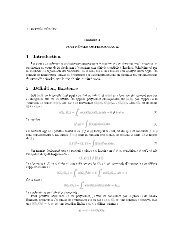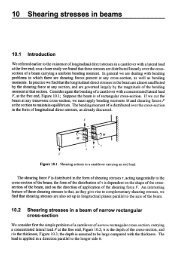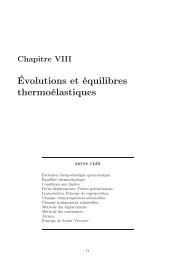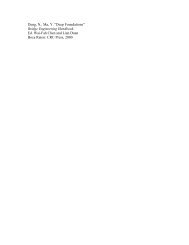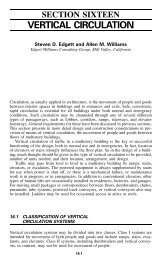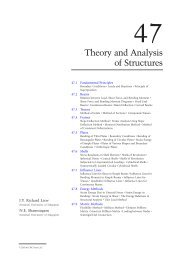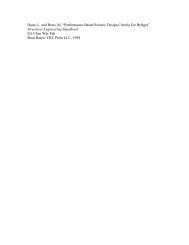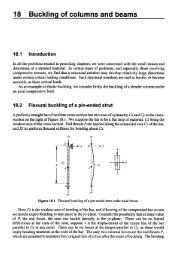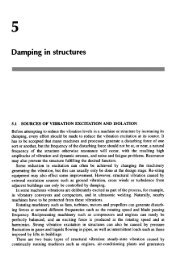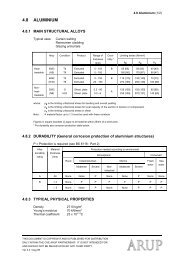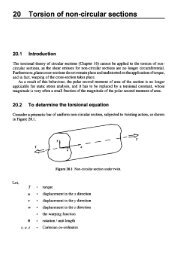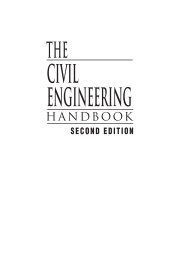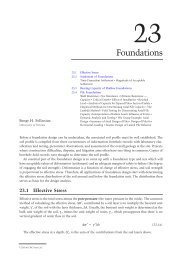Chapter 18: Groundwater and Seepage - Free
Chapter 18: Groundwater and Seepage - Free
Chapter 18: Groundwater and Seepage - Free
You also want an ePaper? Increase the reach of your titles
YUMPU automatically turns print PDFs into web optimized ePapers that Google loves.
<strong>18</strong>-12 The Civil Engineering H<strong>and</strong>book, Second EditionTshx2.01.5to ∞+b′khQ curve2.01.5y+ d′(a)sT = 0.5N fNe=Qkh1.0+ dQkh curve1.0KhQ(c)sT = 0.80.5+bc+0 0.2 0.4 0.6 0.8 1.0(b)sT = 0.2a0.5sTFIGURE <strong>18</strong>.10 Example <strong>18</strong>.3.(d ) (e)Solution. We first note that the section is symmetrical about the y axis, hence only one-half of a flownet is required. Values of the ratio s/T range from 0 to 1, with 0 indicating no penetration <strong>and</strong> 1 completecutoff. For s/T = 1, Q/kh = 0 [see point a in Fig. <strong>18</strong>.10(b)]. As the ratio of s/T decreases, more flowchannels must be added to maintain curvilinear squares <strong>and</strong>, in the limit as s/T approaches zero, Q/khbecomes unbounded [see arrow in Fig. <strong>18</strong>.10(b)]. If s/T = 1/2 [Fig. <strong>18</strong>.10(c)], each streamline willevidence a corresponding equipotential line in the half-strip; consequently, for the whole flow region,N f /N e = 1/2 for s/T = 1/2 [point b in Fig. <strong>18</strong>.10(b)]. Thus, without actually drawing a single flow net, wehave learned quite a bit about the functional relationship between Q/kh <strong>and</strong> s/T. If Q/kh was known fors/T = 0.8 we would have another point <strong>and</strong> could sketch, with some reliability, the portion of the plotin Fig. <strong>18</strong>.10(b) for s/T ≥ 0.5. In Fig. <strong>18</strong>.10(d) is shown one-half of the flow net for s/T = 0.8, which yieldsthe ratio of N f /N e = 0.3 [point c in Fig. <strong>18</strong>.10(b)]. As shown in Fig. <strong>18</strong>.10(e), the flow net for s/T = 0.8can also serve, geometrically, for the case of s/T = 0.2, which yields approximately N f /N e = 0.8 [plottedas point d in Fig. <strong>18</strong>.10(b)]. The portion of the curve for values of s/T close to 0 is still in doubt. Notingthat for s/T = 0, kh/Q = 0, we introduce an ordinate scale of kh/Q to the right of Fig. <strong>18</strong>.10(b) <strong>and</strong> locateon this scale the corresponding values for s/T = 0, 0.2, <strong>and</strong> 0.5 (shown primed). Connecting these points(shown dotted) <strong>and</strong> obtaining the inverse, Q/kh, at desired points, the required curve can be had.A plot giving the quantity of discharge (Q/kh) for symmetrically placed pilings as a function of depthof embedment (s/T ), as well as for an impervious structure of width (2b/T ), is shown in Fig. <strong>18</strong>.11. Thisplot was obtained by Polubarinova-Kochina [1962] using a mathematical approach. The curve labeledb/T = 0 applies for the conditions in Example <strong>18</strong>.3. It is interesting to note that this whole family of© 2003 by CRC Press LLC



